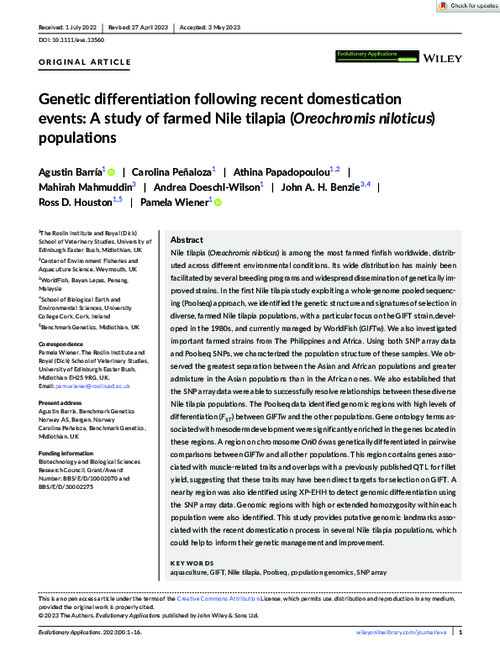Please use this identifier to cite or link to this item:
https://hdl.handle.net/20.500.12348/5553
Genetic differentiation following recent domestication events: A study of farmed Nile tilapia (Oreochromis niloticus) populations
| dc.creator | Barria, A. | en_US |
| dc.creator | Penaloza, C. | en_US |
| dc.creator | Papadopoulou, A. | en_US |
| dc.creator | Mahmuddin, M. | en_US |
| dc.creator | Benzie, J. | en_US |
| dc.creator | Houston, R. | en_US |
| dc.creator | Wiener, P. | en_US |
| dc.date.accessioned | 2023-07-06T16:05:47Z | |
| dc.date.available | 2023-07-06T16:05:47Z | |
| dc.date.issued | 2023 | en_US |
| dc.identifier.citation | Agustin Barria, Carolina Penaloza, Athina Papadopoulou, Mahirah Mahmuddin, John Benzie, Ross Houston, Pamela Wiener. (22/6/2023). Genetic differentiation following recent domestication events: A study of farmed Nile tilapia (Oreochromis niloticus) populations. Evolutionary Applications, 16 (6), pp. 1220-1235. | en_US |
| dc.identifier.issn | 1752-4563 | en_US |
| dc.identifier.uri | https://hdl.handle.net/20.500.12348/5553 | |
| dc.description.abstract | Nile tilapia (Oreochromis niloticus) is among the most farmed finfish worldwide, distributed across different environmental conditions. Its wide distribution has mainly been facilitated by several breeding programs and widespread dissemination of genetically improved strains. In the first Nile tilapia study exploiting a whole-genome pooled sequencing (Poolseq) approach, we identified the genetic structure and signatures of selection in diverse, farmed Nile tilapia populations, with a particular focus on the GIFT strain, developed in the 1980s, and currently managed by WorldFish (GIFTw). We also investigated important farmed strains from The Philippines and Africa. Using both SNP array data and Poolseq SNPs, we characterized the population structure of these samples. We observed the greatest separation between the Asian and African populations and greater admixture in the Asian populations than in the African ones. We also established that the SNP array data were able to successfully resolve relationships between these diverse Nile tilapia populations. The Poolseq data identified genomic regions with high levels of differentiation (FST) between GIFTw and the other populations. Gene ontology terms associated with mesoderm development were significantly enriched in the genes located in these regions. A region on chromosome Oni06 was genetically differentiated in pairwise comparisons between GIFTw and all other populations. This region contains genes associated with muscle-related traits and overlaps with a previously published QTL for fillet yield, suggesting that these traits may have been direct targets for selection on GIFT. A nearby region was also identified using XP-EHH to detect genomic differentiation using the SNP array data. Genomic regions with high or extended homozygosity within each population were also identified. This study provides putative genomic landmarks associated with the recent domestication process in several Nile tilapia populations, which could help to inform their genetic management and improvement. | en_US |
| dc.format | en_US | |
| dc.language | en | en_US |
| dc.publisher | Wiley Open Access | en_US |
| dc.rights | CC-BY-4.0 | en_US |
| dc.source | Evolutionary Applications;16,(2023) Pagination 1220-1235 | en_US |
| dc.subject | gift | en_US |
| dc.subject | population genomics | en_US |
| dc.subject | snp array | en_US |
| dc.subject | poolseq | en_US |
| dc.title | Genetic differentiation following recent domestication events: A study of farmed Nile tilapia (Oreochromis niloticus) populations | en_US |
| dc.type | Journal Article | en_US |
| cg.contributor.funder | CGIAR Research Program on Fish Agri-Food Systems | en_US |
| cg.contributor.funder | Biotechnology and Biological Sciences Research Council | en_US |
| cg.contributor.funder | University of Edinburgh, College of Medicine & Veterinary Medicine, The Roslin Institute | en_US |
| cg.subject.agrovoc | aquaculture | en_US |
| cg.subject.agrovoc | nile tilapia | en_US |
| cg.subject.agrovoc | Fish | en_US |
| cg.contributor.affiliation | WorldFish | en_US |
| cg.contributor.affiliation | University of Lausanne | en_US |
| cg.contributor.affiliation | University College Cork | en_US |
| cg.contributor.affiliation | University of Edinburgh, College of Medicine & Veterinary Medicine, The Roslin Institute | en_US |
| cg.identifier.status | Open access | en_US |
| cg.identifier.ISIindexed | ISI indexed | en_US |
| cg.contribution.worldfishauthor | Mahmuddin, M. | en_US |
| cg.contribution.worldfishauthor | Benzie, J. | en_US |
| cg.description.theme | Sustainable aquaculture | en_US |
| dc.identifier.doi | https://dx.doi.org/10.1111/eva.13560 | en_US |
| cg.creator.id | Mahirah Mahmuddin: 0000-0002-4907-7784 | en_US |
| cg.creator.id | John Benzie: 0000-0001-9599-8683 | en_US |
Files in this item
This item appears in the following Collection(s)
-
Sustainable aquaculture [2735]
